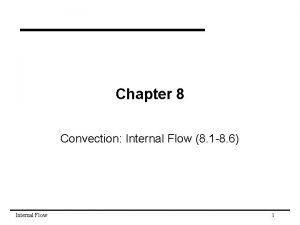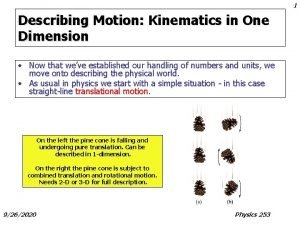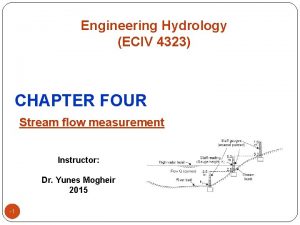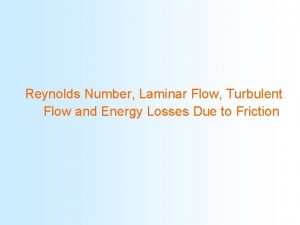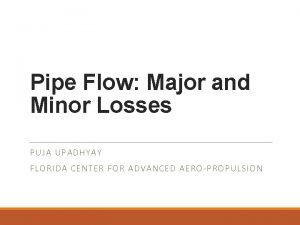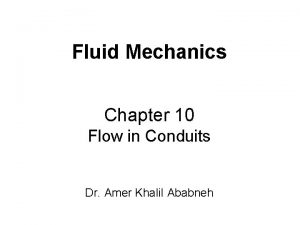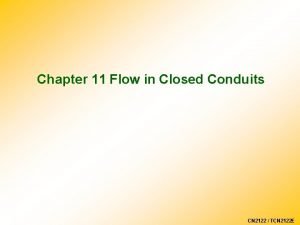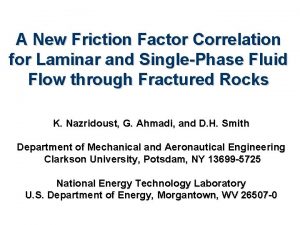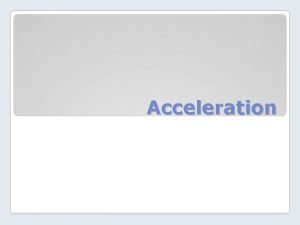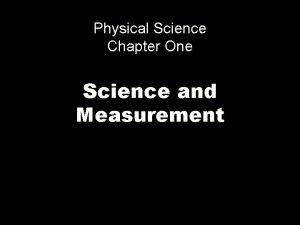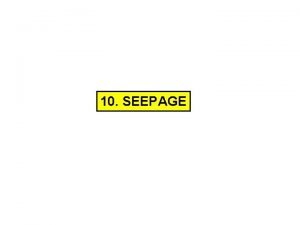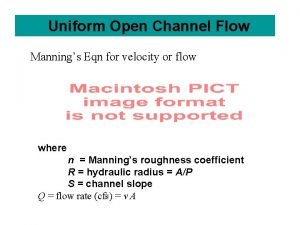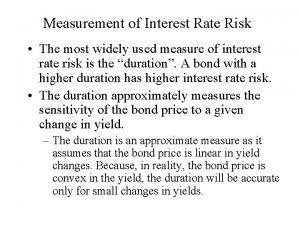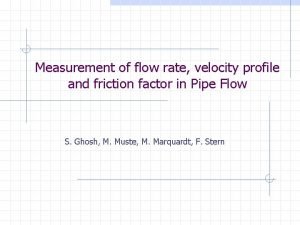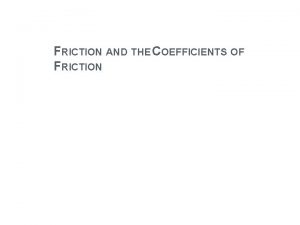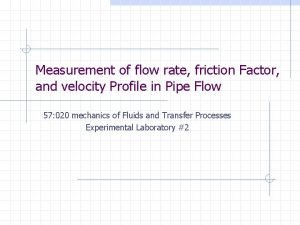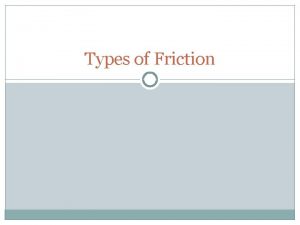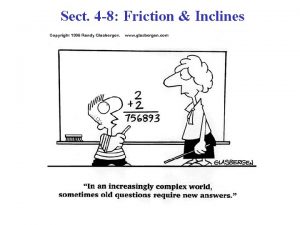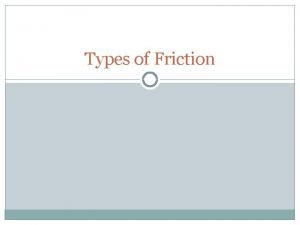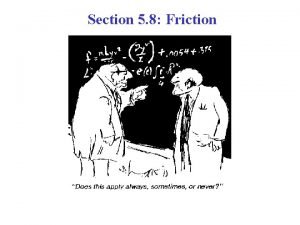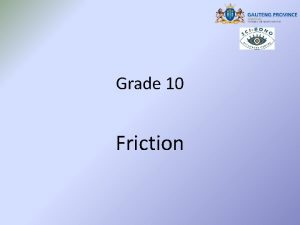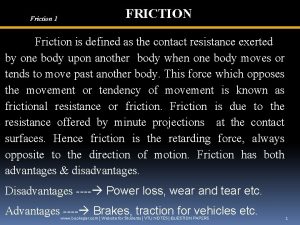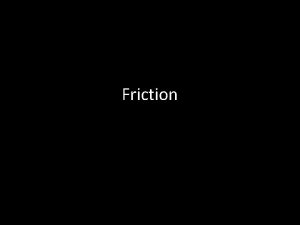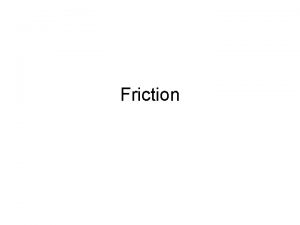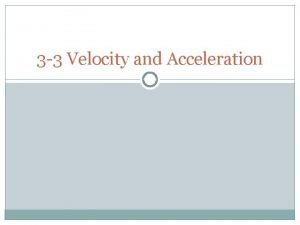Measurement of flow rate velocity profile and friction



























- Slides: 27

Measurement of flow rate, velocity profile and friction factor in Pipe Flow S. Ghosh, M. Muste, F. Stern

Overview Purpose Experimental design Experimental Process n n n Test Set-up Data acquisition Data reduction Uncertainty analysis Data analysis

Purpose Provide hands-on experience with pipe stand facility and modern measurement systems including pressure transducers, pitot probes and computer data acquisition and data reduction. Comparison between automated and manual data acquisition systems. Measure flow rate, velocity profiles and friction factor in smooth and rough pipes. Determine experimental uncertainties. Compare results with benchmark data

Experimental Design The facility consists of: Closed pipe network Fan Reservoir Instrumentation: 3 Venturi meters Contraction Diameters (mm): 12. 7 25. 4 52. 93 Flow Coefficient, K 0. 915 0. 937 0. 935 Simple water Manometer Differential Water manometer Pitot Probe Digital Micrometer (Accurate radial positioning) Pressure transducer Computer based Automated Data Acquisition System (DA)

Experimental process

Test set-up

Test Set-up: Venturi meter and Pitot-tube housing Venturimeter Pitot-tube housing

Test set-up: Instrumentation The equipment used in the experiment includes: Digital thermometer with a range of – 40 to 450 F and a smallest reading of 0. 1 F for measurement of the environment temperature. Digital micrometer with least significant digit 0. 01 mm for positioning the Pitot-tube inside the pipe. Simple water manometer with a range of 2. 5 ft and a least scale division of 0. 001 ft for measurement of the head at each pressure tap along the pipes and for measurement of velocities using the Pitot-tube arrangement. Differential water manometer with a range 3 ft and a least scale division of 0. 001 ft for measurement of the head drop across the Venturi meters. Pressure transducer calibrated with ft of water

Test set-up: Instrumentation Reservoir: Digital Micrometer: w. To build up pressure and force the air to w. Allows the measurement of the position of Pitot Probe: Venturi meters: w. Located in the glass-wall box w. Used to measure the Stagnation pressure w. Located on each pipe type w. Used to measure flow rate Q along the Pressure Taps: Manometers: w. Located along each pipe, they are w. To measure the head at each pressure Tap flow downstream through any of the three straight experiment pipes. and calculate the velocity profile in pipe connected to the simple water manometer to evaluate the head measurement w. They are used to calculate the friction factor the Pitot probe at different locations along the cross section of the pipe tested differential water manometer along the pipe and to make the Pitot-tube measurements (simple Manometer) w. To measure head drops across the venturi meters (differential Manometer)

Data acquisition The procedures for data acquisition and reduction are described as follow: 1. 2. 3. 4. Use the appropriate Venturi meter, (2” contraction diameter) to measure the total discharge. Increase blower setting from 15% to 35% with 5% increments and measure flow rate using both manometer and pressure transducer. Take reading for ambient air (manometer water) and pipe air temperatures. To obtain velocity data, use the Pitot-tube box to measure the ambient head and stagnation heads across the pipe. Measure the stagnation heads at radial intervals. The recommended radial spacing for one half of the diameter is 0, 5, 10, 15, 20, 23, and 24 mm. Maintaining the discharge at 35%, measure the head along the pipe by means of the ADAS the pressure heads at pressure taps 1, 2, 3, and 4 5. Repeat step 2

Automated Data Acquisition System (a) (b) Layout of the data acquisition systems: a) photo; b) schematic

Introduction to ADAS Software - Labview Front panel on Data Acquisition program

Initial settings

Flow rate measurement

Friction factor measurement

Velocity profile measurement

Data reduction For the flow rate and friction factor, the individual measurements are performed for: n n Ambient air temperature Pipe pressure head Venturi meter pressure head drop The experimental Results are: n n n Manometer water density Air density Kinematic viscosity Flow rate Reynolds number Friction factor Data reduction equations are:

Data reduction equations: Flow rate Volumetric flow rate Equation (1), lab handout

Friction factor

Friction factor (contd. ) Equation 2 is a form of Darcy Weisbach equation in terms of flow rate Q and pressure drop where, and A is the pipe cross sectional area.

Velocity profile Equation 3, Exercise notes

Data reduction: Spreadsheet

Uncertainty analysis Block diagram of the experimental determination of the Friction factor Block diagram of the Velocity measurement

Uncertainty Analysis The data reduction equation for the friction factor is: However here we will only consider bias limits for ZSM i and ZSM j. The total uncertainty for the friction is: The Bias Limit, Bf and the precision limit, Pf, for the result are given by:

Uncertainty Analysis (continue) Data Reduction equation for the velocity profile is as follow:

Data Analysis: Results and discussions Moody Chart for pipe friction with smooth and rough walls Low speed = 44 m/s Smooth Pipe (2”) low speed Rough Pipe (2”) low speed 07/10/03 Benchmark data for Friction Factor

Data Analysis: Results and discussions (contd. ) r/R u/umax 0. 0000 1. 0000 0. 1000 0. 9950 0. 2000 0. 9850 0. 3000 0. 9750 0. 4000 0. 9600 0. 5000 0. 9350 0. 6000 0. 9000 0. 7000 0. 8650 0. 8000 0. 8150 0. 9000 0. 7400 0. 9625 0. 6500 0. 9820 0. 5850 1. 0000 0. 4300 Benchmark data for velocity profile (Schlichting, 1968) Low speed = 44 m/s High speed = 62 m/s
 Internal flow examples
Internal flow examples Where do you need high friction when climbing
Where do you need high friction when climbing Linear acceleration and angular acceleration
Linear acceleration and angular acceleration Initial velocity and final velocity formula
Initial velocity and final velocity formula Site:slidetodoc.com
Site:slidetodoc.com Darcy velocity equation
Darcy velocity equation Is v final velocity
Is v final velocity Instantaneous velocity vs average velocity
Instantaneous velocity vs average velocity Darcy velocity vs actual velocity
Darcy velocity vs actual velocity Angular velocity to tangential velocity
Angular velocity to tangential velocity Tension at highest point in vertical circle
Tension at highest point in vertical circle Streamflow measurement by area velocity method
Streamflow measurement by area velocity method Surface profile measurement
Surface profile measurement Reynolds number units
Reynolds number units Head loss
Head loss Flow through pipes
Flow through pipes Friction factor for laminar flow
Friction factor for laminar flow Friction factor for laminar flow
Friction factor for laminar flow The rate at which velocity changes is called
The rate at which velocity changes is called The rate at which velocity changes
The rate at which velocity changes What is rate of change of velocity
What is rate of change of velocity V_f = v_i + aδt
V_f = v_i + aδt Rate of seepage formula
Rate of seepage formula Velocity eqn
Velocity eqn Measuring interest rate risk
Measuring interest rate risk What is real interest rate and nominal interest rate
What is real interest rate and nominal interest rate Plant growth definition
Plant growth definition Option adjusted spread
Option adjusted spread
